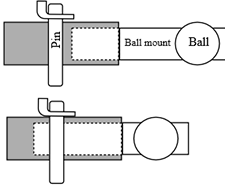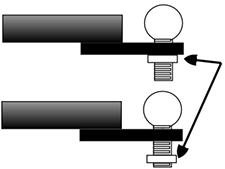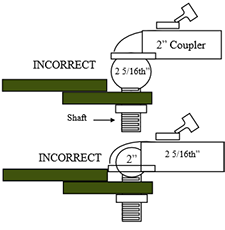Proper Procedure For Hitching Bumper Pull Trailers
This Month’s Trailer Talk is About HITCHING UP BUMPER PULLS
Check, and re-check when hitching up. Small, missed details can cause large, serious accidents. Here is what you need to know:
QUICK TIPS
The tongue weight of your trailer may push the rear of your tow vehicle down when you hitch it up. If the front of the trailer is slightly unlevel with the nose down after hitching up, more weight is on the forward trailer axle. This will cause the trailer to sway. With the front of the trailer slightly up, a bit more weight will be on the rear axle. This will eliminate sway allowing the trailer to track well while traveling. Leveling a trailer correctly is achieved by either using correct, interchangeable ball mounts, available in 0″, 2″, 4″, and 6″ drops or by adjusting the coupler. All EquiSpirit trailers come with height-adjustable couplers to assist in leveling the trailer.
All hitch balls for horse trailers are either 2″ or 2-5/16″, so all trailer couplers are either 2″ or 2-5/16″. The coupler size is stamped on the coupler. The ball size is stamped on the top of the ball. Make sure they match. Note that a 2-5/16 inch coupler will drop onto the 2″ ball, but will “pop off” on the first hard bump while traveling. A 2″ coupler will not drop onto a 2-5/16″ ball – it will sit on top and not hitch correctly creating a dangerous situation if towing is attempted.
 Check the ball mount weight rating. It is stamped on the ball mount. Check the ball rating stamped on the top of the ball too. The ratings should match and be equal or greater than the frame mounted hitch rating. The hitch rating is located on a sticker on the side of the hitch. The shaft of a ball determines its strength and rating. It should fit snugly into the hole on the ball mount. If the ball mount is not inserted all the way into the frame mounted receiver hitch, the locking pin could be inserted behind the ball mount giving the impression that the ball mount is secure. After installing the pin, pull on the ball mount forward to make sure it does not slide out of the frame mounted hitch receiver.
Check the ball mount weight rating. It is stamped on the ball mount. Check the ball rating stamped on the top of the ball too. The ratings should match and be equal or greater than the frame mounted hitch rating. The hitch rating is located on a sticker on the side of the hitch. The shaft of a ball determines its strength and rating. It should fit snugly into the hole on the ball mount. If the ball mount is not inserted all the way into the frame mounted receiver hitch, the locking pin could be inserted behind the ball mount giving the impression that the ball mount is secure. After installing the pin, pull on the ball mount forward to make sure it does not slide out of the frame mounted hitch receiver.
The break-away cord has to be attached to the frame mounted hitch and be free from possible entanglement.
 Make sure the nut that fastens the ball onto the receiver is tight. If not, it can work its way down the threads and eventually come off. If you are trailering and hear a “clunk,” it could be from the ball moving up and down in the ball mount.
Make sure the nut that fastens the ball onto the receiver is tight. If not, it can work its way down the threads and eventually come off. If you are trailering and hear a “clunk,” it could be from the ball moving up and down in the ball mount.
For related safety information about COUPLERS click this link.











